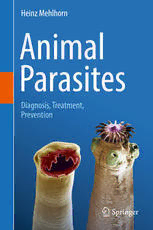
Animal Parasites: Diagnosis, Treatment, Prevention PDF
Preview Animal Parasites: Diagnosis, Treatment, Prevention
Heinz Mehlhorn Animal Parasites Diagnosis, Treatment, Prevention Animal Parasites Heinz Mehlhorn Animal Parasites Diagnosis, Treatment, Prevention HeinzMehlhorn DepartmentofParasitology HeinrichHeineUniversity D€usseldorf,Germany Thisisanupdatedtranslationofthe7theditionoftheGermanbook“DieParasitenderTiere” (2012)publishedbySpringerSpektrum. ISBN978-3-319-46402-2 ISBN978-3-319-46403-9 (eBook) DOI10.1007/978-3-319-46403-9 LibraryofCongressControlNumber:2016956719 #SpringerInternationalPublishingSwitzerland2016 Thisworkissubjecttocopyright.AllrightsarereservedbythePublisher,whetherthewholeorpartof the material is concerned, specifically the rights of translation, reprinting, reuse of illustrations, recitation, broadcasting, reproduction on microfilms or in any other physical way, and transmission or information storage and retrieval, electronic adaptation, computer software, or by similar or dissimilarmethodologynowknownorhereafterdeveloped. The use of general descriptive names, registered names, trademarks, service marks, etc. in this publicationdoesnotimply,evenintheabsenceofaspecificstatement,thatsuchnamesareexempt fromtherelevantprotectivelawsandregulationsandthereforefreeforgeneraluse. Thepublisher,theauthorsandtheeditorsaresafetoassumethattheadviceandinformationinthis book are believed to be true and accurate at the date of publication. Neither the publisher nor the authors or the editors give a warranty, express or implied, with respect to the material contained hereinorforanyerrorsoromissionsthatmayhavebeenmade. Coverillustration:Left:ScanningelectronmicrographoftheanteriorendofthehookwormAncylostoma caninumshowingtypicalteeth.Right:Scanningelectronmicrographoftheanteriorendofatapewormof thegenusTaeniashowingaspeciesspecificcrownofhooksbesidesthesuckers.PhotosHeinzMehlhorn Printedonacid-freepaper ThisSpringerimprintispublishedbySpringerNature TheregisteredcompanyisSpringerInternationalPublishingAG Theregisteredcompanyaddressis:Gewerbestrasse11,6330Cham,Switzerland The Structure of the Book and How to Use the Diagnostic Keys Contents Chaps.1–3explainwhatparasitismmeans,wheresuchanimalsliveandhowthey canbediagnosedmosteasily. Chaps.4–6presentthemostimportantparasitesofanimals.Usingthetablesin Chap. 2, where the different parasites are listed according to their site of occur- rence, it becomes easy to find the relevant chapter in the book where a detailed descriptionisgiveninadditiontomicrographsandsummarizingtables. How to Use the Diagnostic Keys In several chapters, a key is provided, which helps to diagnose some important parasites.Thekeysshouldbeusedasfollows: – Theuserofthebookgetsingeneral2(rarely3)choicesofanswersonquestions related to morphologic aspects of a given parasitic stage (explained in the text and/orshownonmicrographs). – Iftheuserhasdecided,he/shefindsattherightsideofthequestionanumberin boldappearance. – Thenhe/shegoestothenextquestionwrittenbehindthisnumberinthenextline andsoon.Itis,however,importanttoreadalwaysallpossibleanswersbeforea decisionismade! – If at the right side the name of a parasite or a group of parasites occurs, the diagnosisiscompletedandtheuserfollowstothegivenpagenumber,wherethe searchedparasiteisdescribedindetail. v vi TheStructureoftheBookandHowtoUsetheDiagnosticKeys Text The parasites of all animals in the close surroundings of humans are described in detail in Chaps. 4–6, which are presented in a sequence with respect to their organizationasprotozoans,worms(helminths)andectoparasites.Eachparasite anditscloselyrelatedgroupsaredescribedinthefollowingsubheadings: 1. Name:Theoriginofthespeciesnamesisexplainedinordertounderstandthe oftencomplicatednames. 2. Geographic distribution/epidemiology: This section gives insights into where the parasite occurs (worldwide, locally, etc.), and it is shown whether theyareofhighorlowimportance. 3. Biology/morphology:Thissectioncoversaspectsoftheappearanceandrepro- ductionoftheparasites. 4. Symptomsofdisease:Themostimportantsymptomsofdiseaseintroducedby thisparasitearelisted. 5. Diagnosis:Thistopiccontainsinformationhowtofindmosteasilyasupposed parasiteinthebodyofahostorinitsfeces,etc. 6. Pathwayofinfection:Thissectiondescribeshowthehostcanbeinfectedwith asupposedparasite. 7. Prophylaxis: This section gives short information about how infections with thediagnosedparasitecanbeavoided. 8. Incubation period: This is the period ranging from the day of infection until firstsymptomsofdiseaseoccur. 9. Prepatent period: This is the period from the day of infection with the diagnosed parasite until first parasitic stages can be diagnosed, which can be transmitted.Theprepatentperiodisoftenshorterthantheincubationperiodso thatotherhostscanbeinfectedwithoutknowingit. 10. Patency:Periodduringwhichaparasitecanbetransmittedtoanotherhost. 11. Therapy:Presentationofmethods/compoundsthatareincommonusetotreat infections.Note:Medicationmaydifferindifferentcountriesduetolocallaws. 12. Furtherreading:Thissectiongivessomerathernewand/orolderbutimpor- tantpapers,whichhelptoapproachrelevantliteratureconcerningadiagnosed parasite. Addenda Addendum A: Antiparasitic Drugs Used for Animals Thisaddendumcontainstableswheredifferentmedicamentsarelistedthatcanbe usedforthetreatmentofinfectionsoccurringinthedifferenthostgroups.Itgives moredetailsthaninthespecialChaps.4–6. TheStructureoftheBookandHowtoUsetheDiagnosticKeys vii Addendum B: Diagnostic Stages Thisaddendumenclosescomparativetableswithadditionalmicrographsofstages ofseveralparasitesofthedifferenthosts. Addendum C: Questions to Test Obtained Knowledge Thisaddendumlists100questionsconcerningimportantanimalparasitesoffering always five potential answers, but only one of them is correct. This allows us to control our own knowledge and is recommended especially for students before examinations.Correctanswersarelistedattheendofthisaddendum. Addendum D: Origin of Figures Theoriginsofthemacro-ormicroscopicalfiguresoftheparasitesusedinthisbook arelisted. Preface Parasitesendangernotonlythehealthofhumansbutalsothatofanimalswhichlive together with humans in homes and on farms. Many groups of parasites are in addition transferable from animals to humans and back. The pathways of transmissions of endoparasites and ectoparasites have obtained increasing impor- tanceinourdaysofglobalizationandglobalwarming.Whileglobalizationoffers easy transportation of agents of diseases from one end of the world to the other, globalwarmingincreasesthechancesofmanyparasites(especiallyectoparasites) to enter new biotopes in formerly cold regions. Before this background, it seems necessary to stabilize and to increase the knowledge on parasites with respect to occurrence, transmission and control. Thus, the contents of this volume are addressedtoveterinariansandstudentsofveterinarymedicinebutalsotoallpeople whokeepfarmanimalsandespeciallytothosewhoareownersofpetanimals. In order to make it easy to find the wanted information, the book presents the relevantknowledgeoneachparasiteunderthefollowing12subheadings: 1. Name 2. Geographicdistribution/epidemiology 3. Biology/morphology 4. Symptomsofdisease 5. Diagnosis 6. Pathwayofinfection 7. Prophylaxis 8. Incubationperiod 9. Prepatentperiod 10. Patency 11. Therapy 12. Furtherreading The correct diagnosis of the different parasitic stages of animals is not only possiblebythedescriptionoftherelevantmethodsbutalsosupportedbymorethan 600micrographs,bymanydiagrammaticrepresentationsaswellasbycomparative tables.Thelistedcontrolmeasurementsrepresenttheactualknowledgeintheyear oftheappearanceofthisbookandshouldalwaysbechecked. ix x Preface Each chapter on a given parasite ends with the presentation of some recent papers,whichallowaretrospectiveofimportantfeaturesoftheparasite. Hundredquestions—eachwithfivechoices—allowpersonalcontrolofourown knowledge.Theyhadbeentestedinmanystudentexaminationstoconfirmasolid knowledge. This book represents the first English edition after seven previous ones in German. D€usseldorf,Germany HeinzMehlhorn June2016 Acknowledgements The representation of a book such as this one, considering a broad spectrum of many features of the same topic, is not possible without the help of experienced colleagues and friends. Thus, this book is based on common books and articles published with renowned colleagues such as Dieter D€uwel, Dieter Eichenlaub, Alfred Otto Heydorn, Thomas L€oscher, Werner Peters ({), Gerhard Piekarski ({), WolfgangRaetherandEberhardSchein({).Furthermore,Iamdeeplyindebtedto my colleagues Johannes Eckert (Z€urich), Axel Haberkorn (Bayer Leverkusen), HeinzHa¨nel(HoechstAG,Frankfurt),AlfredOttoHeydorn(Berlin),SvenKlimpel (Frankfurt), Gerd Lehmann (Aalbaum), Brigitte Loos-Frank (Stuttgart), Gerhard Piekarski({)(Bonn),RainerPospichel(BayerAG),RegineRibbeck(Leipzig)and Eberhard Schein ({) (Berlin) for their contribution of beautiful pictures, their advices and/or nice glass slides to prepare rare aspects of parasites. Dr. Volker Walldorf (D€usseldorf) and Mr. Fried Theissen ({) (Essen) contributed nice drawingsespeciallypreparedfromdrafts. My son Tim, Mrs. Diehl and my wife Birgit helped in translating the text into English. The preparation of the text was done by Mrs. Inge Schaefers and Mrs. Susanne Walter. Presentation of the figures was accomplished by Mrs. Isabelle Mehlhorn,Mrs.SusanneWalterandMr.BerndPr€umm. The staff at Springer Heidelberg (Drs. Andrea Schlitzberger and Lars K€orner) finishedthisbookinitshopefullyveryusefulandagreeablefinalversion. D€usseldorf,Germany HeinzMehlhorn June2016 xi
